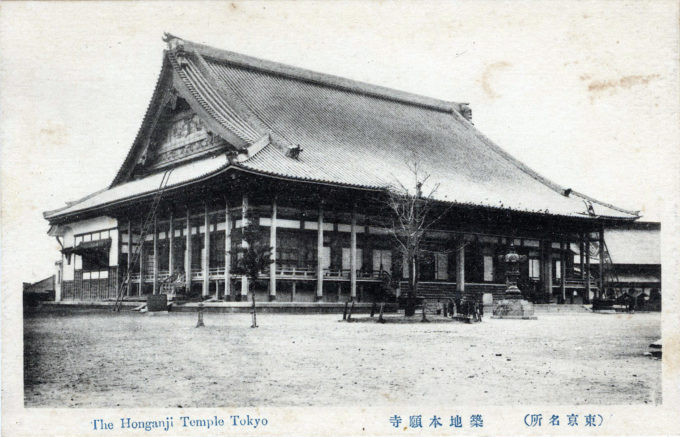
Honganji Temple, Tsukiji, Tokyo, c. 1935. The post-earthquake reconstruction of the temple was said to not be as grand as its more traditionally designed Meiji-era predecessor but is instead an intriguing architectural nod to Buddhism’s Indian origin.
“Then there are curious exercises in styles neither Western nor Japanese. Chief among them, probably, is the Honganji Temple in Tsukiji, not far from the fish market, the villa where General and Mrs. Grant stayed, and the site of the Meiji foreign settlement.
“The principal east country temple of the pietist Shin Buddhist sect, the Honganji was in Edo from the early seventeenth century and has been in Tsukiji since the great fire of 1657. It was twice burned in Meiji. At the time of the earthquake the complex – much grander than now exists – had a main hall in an imposing courtly style. This too was lost.
“The rebuilding, in stone, from 1931 to 1935, is a representation of an Indian temple. So it seeks to take us back to the origins of Buddhism, to which the name ‘Honganji’ also reverts. One of a kind, it looks stranger, there in one of the more unchanged parts of the city, than would a glass block from New York City. A lady in Tanizaki’s The Makioka Sisters calls it ‘that odd building.’ It is highly unlikely that she would have so characterized a foreign exercise of the Western sort.”
– Tokyo from Edo to Showa 1867-1989: The Emergence of the World’s Greatest City, by Edward Seidensticker, 2011
“Tsukiji Hongan-ji is a Jodo Shinshu Buddhist temple located in the Tsukiji district of Tokyo. Its predecessor was the temple of Edo-Asakusa Gobo. It burned during a city-wide fire in 1657, and the shogunate refused to allow it to be rebuilt in Asakusa. Instead, the temple was moved to a new parcel of land being reclaimed by the Sumida River – today’s Tsukiji. This land was said to have been reclaimed by Jodo Shinshu followers themselves who lived at nearby Tsukudajima. The present Tsukiji Hongan-ji was designed by Itō Chūta of the University of Tokyo and built between 1931 and 1935. It is noted for its unique architecture, influenced by temples in South Asia.
“Hongan-ji is a pilgrimage destination due to its artifacts of Prince Shotoku, Shinran Shonin, and Shonyō Shōnin, the 23rd monshu [keeper of the gate] who is enshrined in the temple in honor of his contributions to the spreading the Jodo Shinshu teachings abroad (so that followers would not be in ‘name only’).”
– Wikipedia



